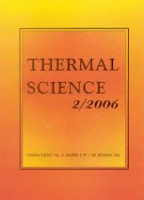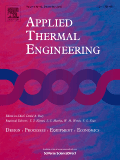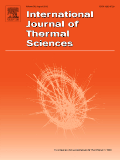
ASME Journal of Heat and Mass Transfer
Scope & Guideline
Exploring the Dynamics of Heat and Mass Transfer
Introduction
Aims and Scopes
- Heat Transfer Mechanisms:
Research on the fundamental mechanisms of heat transfer including conduction, convection, and radiation, with applications in various engineering systems. - Thermal Management Systems:
Development and optimization of thermal management solutions for electronic devices, automotive applications, and industrial processes to enhance efficiency and performance. - Phase Change Materials:
Studies focused on the use of phase change materials (PCMs) for thermal energy storage, including their thermal properties and applications in renewable energy systems. - Numerical and Computational Methods:
Application of numerical methods, computational fluid dynamics (CFD), and mathematical modeling to solve complex heat and mass transfer problems. - Experimental Techniques:
Innovative experimental methodologies for measuring and analyzing heat and mass transfer, including advanced diagnostic tools and techniques. - Multiscale Modeling:
Research that integrates various scales of analysis, from microscale interactions to macroscale system behavior, to provide comprehensive insights into heat transfer processes.
Trending and Emerging
- Artificial Intelligence in Thermal Analysis:
The integration of artificial intelligence and machine learning techniques for predicting heat transfer behaviors and optimizing thermal systems is gaining momentum. - Nanofluids and Advanced Coolants:
Research into nanofluids and other advanced cooling fluids is trending, focusing on their enhanced thermal properties and applications in high-performance heat exchangers. - Sustainable Energy Systems:
There is a growing emphasis on heat transfer research related to renewable energy systems, including solar thermal applications and energy storage technologies. - Biomedical Applications of Heat Transfer:
Increasing attention is being paid to the role of heat transfer in biomedical applications, particularly in cancer treatment and thermal therapies. - Micro and Nanoscale Heat Transfer:
Studies exploring heat transfer phenomena at micro and nanoscale levels are emerging, driven by advancements in nanotechnology and materials science. - Interfacial Heat Transfer Phenomena:
Research focusing on interfacial heat transfer, particularly in multiphase systems and at material interfaces, is becoming increasingly relevant in various applications.
Declining or Waning
- Traditional Heat Exchanger Designs:
Research focused on conventional heat exchanger designs has seen a decrease, as newer technologies and optimization techniques gain traction. - Single-Phase Flow Studies:
Investigation of single-phase flow phenomena is becoming less prevalent compared to the growing interest in multiphase flow and nanofluids. - Basic Heat Transfer Correlations:
While foundational heat transfer correlations are essential, there is a noticeable decline in studies solely focused on these traditional correlations, as researchers seek more complex, application-specific models. - Simplistic Thermal Modeling:
Basic thermal modeling approaches are being overshadowed by more sophisticated and integrative modeling techniques that consider multiple physical phenomena. - Static Thermal Analysis:
Static analyses that do not consider dynamic or transient conditions are becoming less common as the demand for real-time thermal management solutions increases.
Similar Journals

Heat Transfer
Exploring the dynamics of heat transfer across disciplines.Heat Transfer, published by WILEY, is a leading open-access journal dedicated to advancing the field of heat transfer science, encompassing innovative research and application across various domains. With an ISSN of 2688-4534 and an E-ISSN of 2688-4542, the journal aims to provide a platform for researchers to disseminate their findings from 2020 to 2024, focusing on condensed matter physics and fluid dynamics. Ranked in the Q2 category for both Condensed Matter Physics and Fluid Flow and Transfer Processes, it showcases articles that contribute significantly to the understanding and utilization of heat transfer mechanisms. Located in the United States at 111 River St, Hoboken, NJ 07030, the journal appeals to a diverse audience, including academic researchers, professionals in engineering, and students seeking to deepen their knowledge in thermal sciences. With a strong emphasis on accessibility, Heat Transfer promotes the exchange of ideas and experimental techniques, ultimately driving innovation and collaboration in the advancement of thermal management technologies.

Archives of Thermodynamics
Innovating Insights into Thermodynamic ProcessesArchives of Thermodynamics is a reputable journal dedicated to the field of thermodynamics, published by the esteemed POLISH ACADEMY OF SCIENCES. With a robust history since its inception in 2003, this journal serves as a critical platform for disseminating high-quality research aimed at advancing knowledge and technology in thermodynamic systems and processes. Recognized for its contribution to the field, it holds a Q3 ranking in the Physics and Astronomy (miscellaneous) category as of 2023, with a respectable Scopus rank of #148 out of 243, placing it within the 39th percentile. Although it follows a traditional access model, the journal's commitment to scholarly excellence ensures that researchers, professionals, and students alike can benefit from its rich archives and ongoing discussions within the scientific community. Situated in Warsaw, Poland, the journal not only reflects a regional dedication to scientific progress, but also engages with global audiences interested in the evolving landscape of thermodynamic research.

Thermal Science
Transforming energy challenges into sustainable solutions.Thermal Science is an esteemed open-access journal published by the Vinca Institute of Nuclear Sciences in Serbia. With a rich focus on the field of thermal science, this journal has established itself as a vital resource for researchers and professionals interested in the dynamics of energy, renewable energy systems, and environmental sustainability. Since its inception in 2001, Thermal Science has dedicated itself to disseminating high-quality research that addresses the challenges of contemporary thermal technologies. The journal has converged its years of publication from 2007 to 2024 and currently holds a Q4 ranking in the category of Renewable Energy, Sustainability, and the Environment, with a Scopus rank of #172 out of 270, placing it in the 36th percentile. This makes it a crucial platform for sharing innovations and findings that contribute to the development of sustainable energy solutions. With open access options available, Thermal Science ensures that knowledge is readily accessible, fostering collaboration and advancement in this critical field.

Journal of Thermal Science
Transforming thermal science into practical solutions.Journal of Thermal Science is a prestigious academic publication dedicated to the field of thermal science and its applications. Published by SPRINGER, this journal has been at the forefront of knowledge dissemination since its inception in 1992 and continues to provide a platform for researchers and professionals to share their innovative findings through high-quality peer-reviewed articles. With its ISSN 1003-2169 and E-ISSN 1993-033X, the journal covers a diverse array of topics related to thermal processes, materials, and engineering, significantly contributing to advancements in Condensed Matter Physics. In the latest rankings, it holds a commendable Q2 category in the 2023 quartiles, further highlighting its relevance with a Scopus ranking of #183/434 in its field, placing it in the top 57th percentile. While currently not offering open access, the journal strives to bridge the gap between theory and practice, making substantial impacts on both academia and industry. Its continued exploration of cutting-edge research ensures that it remains a key resource for students and professionals looking to expand their knowledge and foster innovation in thermal sciences.

International Journal of Heat and Technology
Exploring the Frontiers of Heat and Fluid DynamicsThe International Journal of Heat and Technology is a premier academic publication dedicated to the dissemination of innovative research in the fields of thermal engineering, fluid mechanics, and condensed matter physics. Published by the INT INFORMATION & ENGINEERING TECHNOLOGY ASSOCIATION and based in Italy, this journal has been a significant resource for researchers and professionals since its inception in 1983, with a commitment to advancing knowledge until 2024. With an impact factor that reflects its relevance, the journal encompasses diverse topics within its scope, bridging gaps between theoretical research and practical applications. Although currently not open access, the journal provides valuable insights into the nuances of heat transfer, flow dynamics, and material properties, making it a critical reference for academia and industry alike. The journal's Scopus rankings position it within the competitive landscape of chemical and mechanical engineering, highlighting its contribution to advancing these fields. We invite scholars, professionals, and students to engage with the rich content provided within its pages, to foster a deeper understanding of heat and technology in our rapidly evolving world.

APPLIED THERMAL ENGINEERING
Empowering engineers with cutting-edge thermal insights.Applied Thermal Engineering is a leading international journal dedicated to the field of thermal engineering, published by Pergamon-Elsevier Science Ltd. With an impressive impact factor indicating its significance in the academic community, this journal focuses on innovative research and developments related to energy engineering, fluid flow, and transfer processes, as well as manufacturing and mechanical engineering. Being indexed in top quartiles (Q1) across multiple categories, it ranks exceptionally well on platforms like Scopus, ensuring that contributors reach a wide and relevant audience. The journal supports both open access and subscription options, promoting the dissemination of vital research findings from 1996 to 2024. With its commitment to advancing the discipline and implementing rigorous peer-review processes, Applied Thermal Engineering serves as an essential resource for researchers, industry professionals, and students aiming to stay abreast of the latest advancements and applied methodologies in thermal science.

JOURNAL OF POROUS MEDIA
Transforming Knowledge into Practical SolutionsJOURNAL OF POROUS MEDIA is a prominent interdisciplinary journal published by Begell House Inc, focusing on the advancement of knowledge related to porous media across various fields, including Biomedical Engineering, Condensed Matter Physics, Materials Science, and Mechanical Engineering. With its ISSN 1091-028X and E-ISSN 1934-0508, this journal serves as a vital platform for researchers and professionals to disseminate groundbreaking findings and foster collaboration within the scientific community. The journal is ranked in the Q2 and Q3 quartiles in multiple categories as of 2023, demonstrating a notable standing in Scopus rankings across several engineering and physics disciplines. Though not an open-access journal, it provides essential insights and advancements within the field of porous media research, encouraging innovative exploration and practical applications in real-world scenarios. Published from 1998 through 2024, JOURNAL OF POROUS MEDIA is an invaluable resource for students, researchers, and industry experts seeking to deepen their understanding of complex porous systems.

Computational Thermal Sciences
Transforming Thermal Processes through Computational ExcellenceComputational Thermal Sciences, an esteemed journal published by BEGELL HOUSE INC, presents cutting-edge research at the intersection of computational mathematics, energy engineering, and fluid dynamics. With an ISSN of 1940-2503 and an E-ISSN of 1940-2554, this journal aims to disseminate high-quality research articles, reviews, and methodologies that improve our understanding of thermal processes and their applications. Renowned for its solid impact in the field, it holds a Q3 ranking in multiple categories including Computational Mathematics and Energy Engineering for 2023. As the field evolves, the journal continues to play a pivotal role in bridging theoretical research with practical innovations, thereby catering to a diverse audience of researchers, professionals, and students. Although it operates on a subscription model, the journal ensures accessibility to significant contributions in thermal sciences from 2009 to 2024, fostering an environment of knowledge sharing and collaboration.

Special Topics & Reviews in Porous Media-An International Journal
Fostering Collaboration in Engineering and Materials ScienceSpecial Topics & Reviews in Porous Media-An International Journal is a prominent academic journal published by BEGELL HOUSE INC, dedicated to the exploration and innovation within the field of porous media. With an ISSN of 2151-4798 and E-ISSN 2151-562X, this journal serves as a key platform for researchers, professionals, and students engaging with topics in engineering and materials science, holding a respectable Q3 ranking in both categories as of 2023. Spanning a publication history from 2010 to 2024, the journal aims to disseminate high-quality, peer-reviewed research that addresses the complexities and advancements in porous materials, facilitating knowledge sharing and fostering collaboration. Although not an open-access journal, it ensures broad accessibility to its valuable content through institutional subscriptions. Positioned at the intersection of theory and practical applications, Special Topics & Reviews in Porous Media plays a crucial role in advancing the understanding of this interdisciplinary field and acts as a significant resource for academics and industry practitioners alike.

INTERNATIONAL JOURNAL OF THERMAL SCIENCES
Pioneering insights into thermal phenomena.The INTERNATIONAL JOURNAL OF THERMAL SCIENCES is a premier academic journal published by ELSEVIER FRANCE-EDITIONS SCIENTIFIQUES MEDICALES ELSEVIER, focusing on cutting-edge research in the field of thermal sciences. With its ISSN 1290-0729 and E-ISSN 1778-4166, this journal has established itself as a crucial resource for scholars and professionals interested in the thermodynamic principles governing engineering and condensed matter physics. The journal is ranked Q1 in both Condensed Matter Physics and Engineering (miscellaneous), highlighting its exceptional quality and influence, as reflected in its impressive Scopus ranks: #32 out of 307 in General Engineering (89th percentile) and #57 out of 434 in Condensed Matter Physics (86th percentile). Researchers and students alike can benefit from the wealth of articles available, with access options designed to foster a wider dissemination of knowledge within the scientific community. Established in 1973 and ongoing through 2025, the journal invites contributions that advance the understanding of thermal phenomena and their applications, solidifying its importance in driving innovation and insight within these dynamic fields.